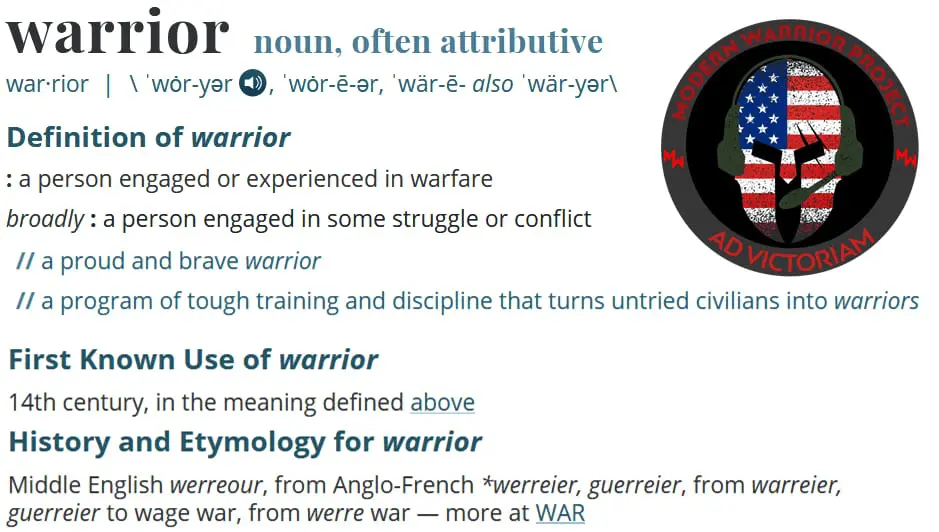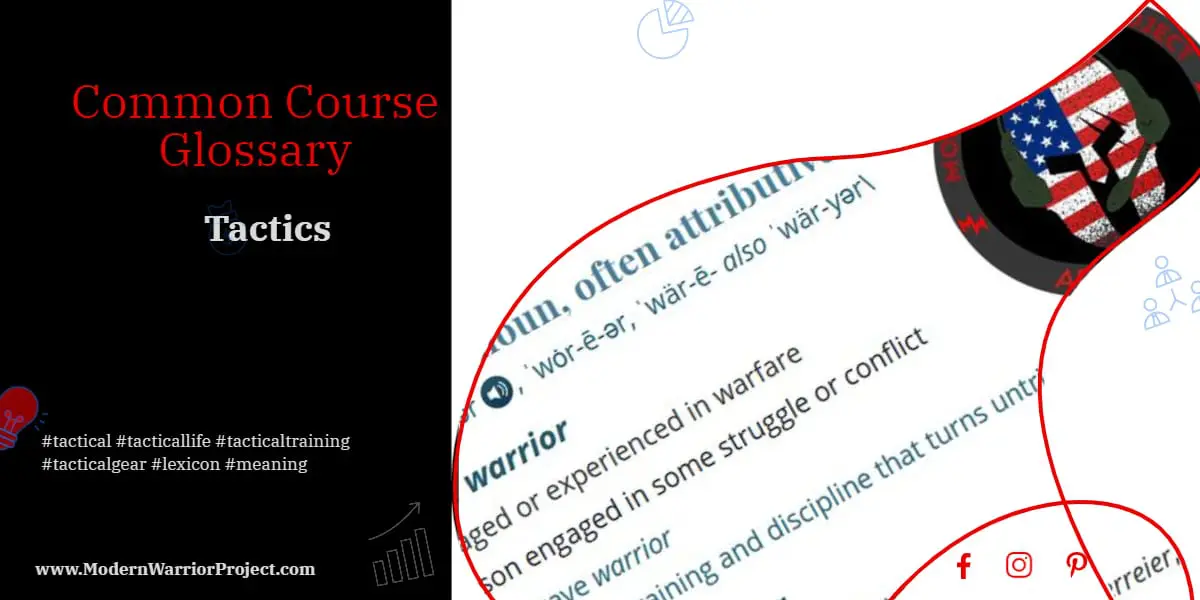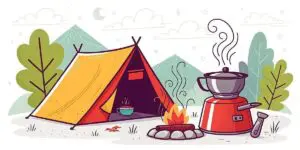TACTICS
In the arena of tactics, it can be overwhelming for a newcomer to try and grasp the terminology used. Furthermore, even the seasoned tactician may come across a new term and all too often is reluctant to clarify the definition for fear of coming across ignorant. Beyond these few issues, the industry in many areas lacks standardization of terms a common lexicon if you will. The Modern Warrior Project hopes to slowly (with your help) change this and create a standard tactics vocabulary across the industry. This will only serve to benefit all involved whether an individual or business. We welcome your feedback and suggestions (both individuals and businesses) in both the comment section as well as via email. While we are heading this effort it is the communities, not ours and we look forward to collaborating together on it.

Academic Terms
Academic Hour – 50 minutes of instruction followed by a 10 minute break
Basic Skills Evaluation (BSE) – a drill designed to measure a Student’s performance of certain tasks against specific standards
Co-Use Range – any range that permits multiple individuals to conduct unrelated live fire training on the same firing line
Desired Learning Outcome (DLO) – the purpose of a course, stated as a list of expected Student performance and proficiency achieved by the end of training
Errors:
>> Critical Error (CE) – any error that prevents the Student from completing the task to standard but does not meet the criteria for a Fatal Error
>> Fatal Error (FE) – any error that jeopardizes the safety of the Student performing the task, other Students participating in the training, or the Instructor; any error that demonstrates a fundamental lack of understanding of the task
>> Minor Error (ME) – any error that degrades the Student’s performance but does not prevent them from completing the task to standard
Habit Loop – the neurological process that governs behavioral routines; comprised of a cue, a routine, and a reward
Interjected Role Play (IJRP) – Role Play conducted without any preconditioning or notification to Students designating a Role Play session has begun (i.e. “spur of the moment”); typically very short duration (a few seconds up to 5 minutes), high intensity, and aimed at a single training objective
Lead Instructor – a single individual identified and present for the entire duration of a course; has overall responsibility and ultimate authority over the conduct of a course; when a certified Modern Warrior Coach is conducting a licensed Modern Warrior course the Lead Instructor with the terms and conditions of the MWP Coach Program Licensing Agreement and be designated by the Modern Warrior Coach whose license they are operating under
Learning – a change in knowledge, skills, or behavior as a result of experience
Negative Habit Transfer – 1) the inadvertent creation of undesirable behavior in a Student that results from placing artificial restrictions or limitations on a Student in a training environment for the sake of safety or efficiency 2) the use of a practice, technique, or response which is appropriate in one circumstance but can be disastrous when applied in a different situation
Negative Transfer – regarding training, the interference of previous knowledge with new learning
Overall Design Assumption (ODA) – the fundamental basis for the design of the Lesson Plan; organized around a constant training environment, a set number of Instructors and Students, and minimum firearm capabilities; the ODA impacts the time required, drill structure, and Risk Assessment
Performance Levels:
>> Acceptable – a level of performance that is capable of meeting the requirement
>> Optimal – a level of performance that is highly desired and in excess of what is necessary to meet the requirement
>> Tolerable – a level of situational awareness that is sufficient enough to support acceptable performance
Proficiency – a measure of competence or skill; an evaluation of performance over a period of time which relies on consistency
Proficiency Levels:
>> Demonstrated [D] – the Instructor has performed the task in its entirety to standard for the Student by first breaking the task down into its individual steps and then working up to the speed at which the task is normally expected to be conducted. Used to introduce new material, explain how a drill will take place, or when providing Student evaluations and feedback
>> Intermediate [I] – Occasional Critical Errors; the Student exhibits a thorough understanding of the elements and mechanics of the task but cannot complete the task to the required level consistently enough to establish their mastery of the skill
>> Knowledge [K] – the Student has been taught the elements and mechanics of the task and can generally describe the task
>> Practiced [P] – the Student understands the elements and mechanics of the task but requires regular assistance, guidance, demonstration, or correction from the Instructor to prevent making Critical Errors
>> Standard [S] – Minor Errors only; the Student can consistently complete the task safely and accurately while maintaining Situational Awareness appropriate to the conditions and without assistance, guidance, or correction from the Instructor
Role Play – a type of dynamic training in which participants behave according to prescribed roles to facilitate a more realistic and meaningful experience
Scenario Based Training (SBT) – immersive Role Play conducted with deliberate implementation involving Student preconditioning and a clear designation of the beginning of the session; can range from a 5 or more minutes to several hours or even days, variable intensity, and aimed at multiple training objectives
Student to Instructor Ratio (STIR) – the maximum number of Students that one Instructor can reasonably be expected to supervise safely while providing adequate feedback
Training Intervention Posture – the physical positioning of an Instructor while supervising a Student conducting a task that allows the Instructor to immediately intervene before an accident can occur
Valid Technique – any method of accomplishing a task that is safe, effective, efficient, and consistent
Vicarious Learning – a change in knowledge, skills, or behavior that results from the indirect observation of another individual’s experience
Comprehensive Situational Control (CSC) Terms
Aggressor – the individual or group whose actions unlawfully endanger others
A.I.M. (Assess. Inventory. Manage.) – a Tactical Decision Making Process (TDMP) model that individuals use to assess a Critical Situation, inventory the tools and skills available to Influence the outcome, and manage the situation through the Avoidance or Recovery stages
Avoidance – before or during a Critical Situation, the action of preventing something from happening
Awareness – regarding the CSC Chain; perception of a situation
Basic Threat ID – the initial evaluation of a person’s hands, eyes, and surroundings for indicators of danger
Casual Defensive Posture (CDP) – a basic athletic stance with hands folded in close proximity to the chest; the position appears non-threatening but allows quick reaction to a Threat; similar to the law enforcement “interview stance”
Circle of Action – the area around an individual that allows for valid Avoidance or Recovery strategies
Close Quarters – any location in which the environment (i.e. proximity of objects, structures, and Threats) provides a limited Circle of Action and minimal opportunities for Avoidance
Circle of Action – the area around an individual that allows for valid Avoidance or Recovery strategies
Combatives – any system of hand-to-hand combat that provides an individual with the ability to protect their self, counter-attack their Aggressor, reduce or Neutralize a Threat, or create an Opportunity to escape
Common Operating Picture (COP) – the shared understanding of the elements of a Critical Situation that all friendly participants have
Comprehensive Situational Control (CSC) – a system of practices and techniques designed to provide individuals with the ability to Recognize and Avoid Critical Situations, or Recover control during them; it is the mindset of a Modern Warrior and its principles are incorporated into all Modern Warrior training
Concealment – any object that provides visual obscuration but does not offer protection from harmful projectiles
Course of Action (COA) – a procedure adopted in response to a given situation; designed to achieve a specific outcome
Cover – any object that provides physical protection from harmful projectiles and generally offers visual obscuration as well
Critical Situation – a set of circumstances for which the Risk and Stakes are exceptionally high
CSC Chain – Knowledge and Awareness lead to Recognition and Avoidance or Recovery
De-escalation – the process of reducing the likelihood for or intensity of a conflict or violent situation; an Avoidance strategy
Extreme Close Quarters (ECQ) – an environment in which an individual is in such close proximity to a Threat that there is little to no definable Reactionary Gap
Fight, Flight, or Freeze – the body’s automatic physiological response to fear or a perceived danger
Fundamentals of Recovery – the framework for an effective approach to regaining control and ending a critical situation; these 8 fundamentals are easily remembered with the acronym “ACTS FELT”
Hazard – an inanimate object, event, or condition (e.g. steep terrain, vehicular traffic, house fire, poor weather, low light environment) that serves as a potential source of danger
Influence – in a Critical Situation, any action, behavior, or item that helps improve or restore Positive Control
Knowledge – regarding the CSC Chain; facts, information, and skills acquired through experience or education
M-E-T Triangle – the Mindset, Equipment, and Training an individual relies on to Influence Critical Situations
Neutralize – to render a Threat or Hazard ineffective or harmless
OODA Loop – a Tactical Decision Making Process (TDMP) model whereby an individual continuously observes the environment, orients their mental and physical capabilities around a problem set, decides on a course of action, and acts to resolve the situation
Opportunity – a set of circumstances that make it possible to do something
P.A.C.E. Planning – an approach to planning where a Primary, Alternate, Contingency, and Emergency method for accomplishing a Course of Action is established
Planned Advantage – an item intentionally pre-positioned or carried for the purpose of Influencing Critical Situations
Point of Domination (POD) – a physical location occupied by force as part of a Recovery strategy; provides for Situational Awareness, reaction time, protection, and a tactical advantage
Point of Influence (POI) – a physical location opportunistically occupied as part of an Avoidance strategy; provides for Situational Awareness, reaction time, protection, and a tactical advantage
Positive Control – in a Critical Situation, the ability to secure the outcome you desire; the goal of Recovery action; the individual or group with the greatest ability to drive the outcome in their favor is said to have Positive Control of the situation
Post Event Sequence – the actions taken once an individual has regained control of a Critical Situation;
1. Gain and maintain situational awareness
2. Move to a safe location
3. Contact the authorities
Pre-Conflict Cues – a signal for action based on an Aggressor’s behavioral indicators of their impending decision to act
Proactive Attitude – the process of determining the most likely Critical Situation to occur for a given set of circumstances and working to prevent it
Proper Use of PEDs – prioritizing Situational Awareness and division of attention over personal electronic devices
Recognition – regarding the CSC Chain; identification of a Threat, situation, or Hazard from previous encounters or knowledge
Recovery – in a Critical Situation, the action or process of regaining Positive Control by force
Risk – in a Critical Situation, the variability of outcome or the ease with which a situation can turn from positive to negative
Security Plan – the combination of physical and procedural security measures in place to protect a person, location, or event; should be layered and oriented around a specific Threat
Self-Defense – the reasonable use of force to protect oneself or others against physical harm from an immediate Threat
Situational Awareness – the perception of environmental elements and events with respect to time and space, the comprehension of their meaning, and the projection of their status after some variable has changed
Speed – 1) the rate at which an action is performed 2) a combat principle emphasizing pace, momentum, and pressure to overwhelm the opposition
Startle – the involuntary, physiological, protective reflex to a sudden intense stimulus
Stake – that which is in jeopardy of being won or lost
Surprise – 1) the state of emotional distress and/or confusion that exists following an unexpected event [also in: Tactical Terms]
Tactical Decision Making Process (TDMP) – in a Critical Situation, the systematic approach to the mental process used to consistently determine the best Course of Action in response to a given set of circumstances
Target – regarding CSC; a person or object that has Value to and provides Opportunity for an Aggressor
Threat – a person that one reasonably believes possesses the Ability, Opportunity, and Desire to endanger one’s life or the lives of those nearby
Threat Types:
>> Developing Threat – an individual or group whose actions are escalating towards becoming dangerous but not yet to the point where they can be classified as a Threat; an Aggressor whose actions are intensifying
>> Disguised Threat – an individual or group that intentionally masks their Ability and Desire to harm you in an effort to increase their Opportunity
>> Obvious Threat – an individual or group that clearly presents all 3 elements of a Threat
Transitional Space – any location that connects multiple environments and provides Aggressors with a tactical advantage such as ease of access, an element of surprise, or a quick escape
Trigger Point – in a Critical Situation, any event which compels Recovery action
Use of Force Window – in a Critical Situation, the period of time during which forcible Recovery action is justifiable
Value – the estimation of something’s worth
Firearms Terms
Condition 0 – for single action and double action/single action firearms in the single action mod; a loaded magazine is installed, a round is chambered, the hammer is cocked, and the safety is off
Condition 1 – for single action and double action/single action firearms in the single action mod; a loaded magazine is installed, a round is chambered, the hammer is cocked, and the safety is on
Condition 2 – for single action, double action/single action firearms in the double action mod, and double action only firearms; a loaded magazine is installed, a round is chambered, and the hammer is down (if applicable)
Condition 3 – for all firearms; a loaded magazine is installed, the chamber is empty, and the hammer is down (if applicable)
Condition 4 – for all firearms; no magazine is installed, the chamber is empty, and the hammer is down (if applicable)
Condition 5 – for all firearms; no magazine is installed or is unloaded if permanently affixed, the chamber is empty, and the action is locked to the rear/open
Tactical Terms
Accuracy – the measure of being correct (Yes or No); in defensive engagements a shot is Accurate if it has the desired effect on the Threat
All Clear – the state of the environment when every area is completely free of Threats or other Hazards
Arc of Movement – the unavoidable motion of a firearm’s sights caused by Translation; the Arc of Movement is always present
Basic Threat ID – the initial evaluation of a person’s hands, eyes, and surroundings for indicators of danger
Casual Defensive Posture (CDP) – a basic athletic stance with hands folded in close proximity to the chest; the position appears non-threatening but allows quick reaction to a Threat; similar to the law enforcement “interview stance”; in training – if using a handgun, the handgun is holstered with all active retention devices engaged and cover garments in place (as applicable); in training – if using a long gun, the firearm is slung in front with both hands on it
Circle of Action – the area around an individual that allows for valid Avoidance or Recovery strategies
Clear [adjective] – a portion of the environment that is free from Threats or other Hazards
Clear [verb] – 1) the act of removing all ammunition from a firearm 2) the act of resolving a malfunction 3) the act of neutralizing Threats or other Hazards in a portion of the environment
Close Quarters – any location in which the environment (i.e. proximity of objects, structures, and Threats) provides a limited Circle of Action and minimal opportunities for Avoidance
Combatives – any system of hand-to-hand combat that provides an individual with the ability to protect their self, counter-attack their Aggressor, reduce or Neutralize a Threat, or create an Opportunity to escape
Common Operating Picture (COP) – the shared understanding of the elements of a Critical Situation that all friendly participants have
Compressed Low Ready (CLR) – the handgun is in close proximity to the center of the chest in a proper two-handed grip with the focus on evaluating the environment
Concealment – any object that provides visual obscuration but does not offer protection from harmful projectiles
Course of Action (COA) – a procedure adopted in response to a given situation; designed to achieve a specific outcome
Cover – any object that provides physical protection from harmful projectiles and generally offers visual obscuration as well
Emergency Reload – an unplanned reload conducted rapidly as a result of the firearm running out of ammunition
Emergency Transition – an unplanned transition conducted rapidly as a result of the firearm in use either running out of ammunition or experiencing a stoppage
Extreme Close Quarters (ECQ) – an environment in which an individual is in such close proximity to a Threat that there is little to no definable Reactionary Gap
Firing Hand – the hand that establishes the primary grip on a firearm and is responsible for pressing the trigger
Focal Point Transition – the process of engaging an area of a target, then shifting focus to engage a separate area of the same target; typically between the Centers of Gravity; eyes lead the muzzle
Full Switch – the act of changing the side of a shooter’s body that a long gun is shouldered on and swapping the Firing Hand with the Reaction Hand
Hazard – an inanimate object, event, or condition (e.g. steep terrain, vehicular traffic, house fire, poor weather, low light environment) that serves as a potential source of danger
Immediate Action – a process for attempting to clear the most common causes of firearm malfunctions; performed immediately after a stoppage occurs
Line of Departure – from a position of cover or relative safety, a theoretical line beyond which an individual is considered to be exposed to the full effects of a Threat or Hazard
Low Ready (LR) – the firearm is in a full two-handed presentation just slightly below the centerline of the target with the focus on evaluating the environment
Neutralize – to render a Threat or Hazard ineffective or harmless
OODA Loop – a Tactical Decision Making Process (TDMP) model whereby an individual continuously observes the environment, orients their mental and physical capabilities around a problem set, decides on a course of action, and acts to resolve the situation
Point of Domination (POD) – a physical location occupied by force as part of a Recovery strategy; provides for Situational Awareness, reaction time, protection, and a tactical advantage
Point of Influence (POI) – a physical location opportunistically occupied as part of an Avoidance strategy; provides for Situational Awareness, reaction time, protection, and a tactical advantage
Post Event Sequence – the actions taken once an individual has regained control of a Critical Situation;
1. Gain and maintain situational awareness
2. Move to a safe location
3. Contact the authorities
Precision – the degree of accuracy when measured against an exact standard (Sliding Scale)
Reaction Hand – the non-firing hand; responsible for supporting a proper two-handed presentation, resolving firearm issues, or interacting with the environment
Reactionary Gap – the time and/or distance needed to effectively react to a given Threat
Red Zone – any portion of the environment that is blocked from the shooter’s view and cannot be Cleared without the shooter changing his position or the cause of the obscuration being removed
Remedial Action – a process for clearing a malfunction that the Immediate Action steps were unable to resolve or a malfunction that the operator determines requires addition steps (e.g. a double feed)
Scan & Breathe – the secondary evaluation of the environment immediately following an engagement, designed to break tunnel vision in order to regain situational awareness and identify other Threats or hazards
Self-Defense – the reasonable use of force to protect oneself or others against physical harm from an immediate Threat
Shooting Fundamentals – the six principles for effectively employing a firearm;
1) Grip
2) Posture
3) Sight Alignment and Sight Picture
4) Breath Control
5) Trigger Control
6) Follow-Through
Shooter’s Platform – a basic athletic stance that allows a shooter to effectively engage Threats while stationary and on the move by reducing Recoil and Translation
Sight Offset – the vertical distance between the centerline of the muzzle and the centerline of a sighting system; must be accounted for when shooting from behind objects to ensure a clear line of travel for the bullet’s flight to the target
Situational Awareness – the perception of environmental elements and events with respect to time and space, the comprehension of their meaning, and the projection of their status after some variable has changed
Slicing the Pie – the technique of systematically and progressively clearing a corner by moving deliberately in an arc around the corner in small segments while assessing each area for Threats; minimizes the shooter’s exposure to the unseen area
Soft Switch – the act of changing the side of a shooter’s body that a long gun is shouldered on without swapping the Firing Hand with the Reaction Hand
Speed – 1) the rate at which an action is performed 2) a combat principle emphasizing pace, momentum, and pressure to overwhelm the opposition
Strike Ready – an alternative ready position for long guns used when breaking the Line of Departure; the stock is held just off of and below the shoulder with the muzzle slightly up in line with the shooter’s line of sight; allows for a more timely engagement of immediate threats
Structural Warfare – physical conflicts that occur in or around manmade buildings or objects
Support Side – the non-dominate half of a shooter’s body
Surprise – 1) a combat principle emphasizing actions that are unexpected by the opposition [also in: CSC Terms]
Tactical Priority – a technique for engaging multiple Threats based on their value (i.e. danger) so as to suppress or Neutralize the highest risk Threats first; priority can be given by the Threat’s proximity to the shooter or the capability of the Threat’s weapon
Tactical Reload – a calculated reload accomplished during a sufficient lull in or after an engagement to return a firearm to full capacity prior to the need for an Emergency Reload
Tactical Sequence – a technique for engaging multiple Threats of equal value (i.e. danger) with a single round initially to suppress or Neutralize them quickly before returning to deliver additional rounds to each as necessary to end the engagement
Tactical Transition – a calculated transition between two firearms done to bring the more appropriate firearm into the action
Target Environment – the area between the shooter and the target, surrounding the target, and beyond the target
Tilt-Up Chamber Check (TUCC) – the action of tilting a handgun’s muzzle slightly upwards or rotating the chamber of a rifle/shotgun skyward whenever the gun fails to fire so that the operator can assess the cause of the stoppage
Transition – the act of rapidly switching from one firearm to another firearm
Transitional Space – any area that connects different environments; provides Aggressors an advantage by reducing a person’s Circle of Action and Situational Awareness
Translation – any external force imparted on a firearm that contributes to the Arc of Movement and disrupts a shooter’s Sight Alignment or Sight Picture, such as from breathing, walking or bumping into a person or object
Violence – a combat principle emphasizing organized and controlled aggression to dominate the opposition or seize control of a key location
Working Space (Pistol) – the designated position for holding a handgun while troubleshooting issues; an area roughly 8-10 inches away from the center of the chest, between the sternum and chin; allows the operator to see the handgun fully while maintaining Situational Awareness
Working Space (Rifle) – the designated position for holding a rifle while troubleshooting issues; the rifle stock is canted slightly up and to the side in the pocket of the shoulder such that the chamber is angled down; allows the operator to see the rifle fully while maintaining Situational Awareness
Safety and Risk Management
Hazard – an inanimate object, event, or condition (e.g. steep terrain, vehicular traffic, house fire, poor weather, low light environment) that serves as a potential source of danger
Risk – regarding Safety and Risk Management; the possible effect of a hazard such as damage, occupational illness, injury, or death; determined by comparing the probability and severity of a hazard; expressed as low, medium, high, extremely high
Check out some of our other resources here






























